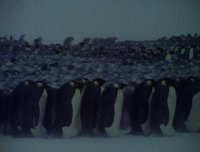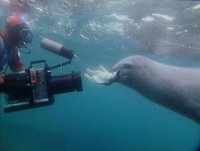Life in the Freezer
|
|
Life in the Freezer is a BBC natural history television series (in conjunction with The National Geographic Society and Lionheart International Limited) of six episodes about life in and around the continent of Antarctica. It is presented by David Attenborough and was originally transmitted in November 1993.
The series was produced by Alistair Fothergill. It took over three years to make.
There is an accompanying book, and the series is available on a single DVD (with no extra material).
| Contents |
Episodes
Each episode is just under 30 minutes long, recorded in 4:3 aspect ratio with stereo sound.
The Bountiful Sea
The first episode introduces the viewers to the continent of Antarctica and the surrounding sea and islands, its glaciers and the icebergs that form from it. It describes how the continent changes throughout the seasons, as it effectively doubles in size in winter when the surrounding sea freezes over, "the greatest seasonal change that takes place on this planet".
Penguins, whales and seals are shown feeding in the Southern Ocean. Many of them feed on the abundant krill (which in turn feed on phytoplankton and ice-algae). Humpback whales are shown catching krill through sophisticated cooperation, by creating spiraling curtains of air bubbles that drive the krill into their center, where the whales can then catch them by surging upwards in the middle of the spiral.
The episode also introduces the various seabirds which feed in the Antarctic sea, especially albatrosses, whose impressive wingspans are possible because they utilize the updraft generated by the huge waves in the stormy southern waters.
Many birds (including penguins) lay their eggs and feed their chicks on the islands surrounding the Antarctic continent, especially South Georgia where both albatross and King Penguins have their nesting sites throughout the year.
LITF-Albatross.jpg
The Ice Retreats
Elephant seals are the first animals to return to the beaches of the subantarctic islands in spring, forming large breeding colonies, where the males fight fierce battles to gain and retain permanent access to a large number of females. They mate with the females as soon as they are receptive again. Millions of Macaroni Penguins form huge colonies on the islands to breed.
The Antarctic peninsula is one of the few regions of the continent inhabited by animals, even in summer. Gentoo Penguins build their nests on bare rock and humpback whales seek krill along the coast, Adelie Penguins nest even further south. Crabeater Seals, one of the most numerous mammals on Earth, live and reproduce in the pack ice zone around Antarctica. Snowy petrels fly many miles into the island to find rock on which to lay their eggs.
The Race to Breed
Almost all life in the region breeds in summer. A growing colony of fur seals on a beach on South Georgia resembles the colony of elephant seals shown in the previous episode. The pups grow fast on the rich, fatty milk provided by their mothers and double their weight in just sixty days. As the females become sexually available, the mating season begins -- males try to claim territory and mate with females. Like elephant seals, fur seals fiercely attack all competitors.
Chinstrap Penguins form large colonies on Deception Island, climbing up its steep slopes to find mountain ridges free of snow. Returning birds find their partners by recognizing their voice (performing a brief greeting ritual when they have found them), which is why the colonies are very noisy during the breeding season. Males and female penguins take turns in catching food, some of which they regurgitate for their chicks when they return.
The summer also thaws some of the ice on the shores of the continent. The fresh water allows moss and other plants to grow, which in turn provide food for mites that are adapted to the cold climate -- they can survive temperatures up to minus 30 degrees Celsius because they contain a kind of antifreeze liquid. They become active as soon as the ice melts, and reproduce whenever they get an opportunity to do so. Lichens grow even further south than moss, and algae populate some of the snow. In the ocean, life is much more diverse, and Blue-eyed Shags dive for fish near the peninsula. More than 300,000 petrels come to breed to the Scullin Monolith, one of the few areas of open rock.

The Door Closes
This episode describes the migration of most animals northwards (some from the Antarctic continent, others from the few islands surrounding it) as the continent and surrounding sea freeze over at the end of summer. It shows how young penguins often fall prey to Leopard Seals as they try to make their way across the already partially frozen water -- and how their stripped remains become food for isopods and meter-long nemerteans (ribbon worms). Before going to the sea, however, the adult penguins must shed their coats (moulting).
The freezing sea ice usually does not reach South Georgia, and seal pups are still fed there by their mothers in autumn to be ready for the winter. They use their remaining time for play and mock fights in the ocean. Those who do not survive become food for the predator birds -- the skuas and the giant petrels. Elephant seals undergo moulting while on the island. Albatross nesting on South Georgia continue to feed and mate, but the ever harsher weather forces most animals further northwards.
The Big Freeze
As almost all animal inhabitants of Antarctica are forced to migrate north, the sea underneath the frozen ice still provides a home to many specially adapted fish whose cells are protected from freezing through an "antifreeze" liquid. Many of them feed on the faeces of other animals.
The most notable larger animal that does not migrate north is perhaps the Weddell Seal, which can be found as close as 1300 kilometres to the pole. Groups of seals tear holes into the ice to dive for food and come up to breathe. The females come back to the ice to give birth.
This episode also describes primitive plant life such as lichen which can still be found on the continent in winter, even in the extremely dry and permanently frozen valleys -- conditions under which dead animals can lie frozen for many centuries without decomposing. It details the life of the Emperor Penguin, "the only birds to lay their eggs directly on ice". While other animals retreat, Emperors migrate not just to the ice, but into the Antarctic continent. The females lay eggs which are incubated by the males under the harshest conditions on Earth (huddling closely together for warmth), while the females return to the sea.

Footsteps In The Snow
This episode discusses the human exploration of Antarctica, in particular the mission led by Captain Robert Falcon Scott, whose team died on the way back from the South Pole. It shows the scientific work in the modern human bases in Antarctica, especially Mawson Base and its observation of Adelie Penguins (partially through tracking devices).
The second half of the episode describes how the series was made. Most crucial was of course the camera work. To get access to the wildlife of the sea, for example, boats, divers, suspended capsules and remotely controlled cameras mounted on inflatables were used. Particularly dangerous to divers were Leopard Seals and other predators. The film concludes that although working in Antarctica is now much easier than during the early days of exploration, human footsteps on the continent are still exceedingly rare -- in part because of international treaties prohibiting industrial exploitation.
